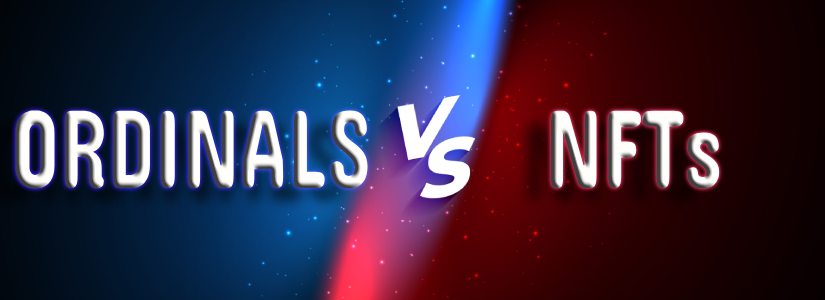In the fast-evolving landscape of cryptocurrencies, where innovation is the norm and possibilities seem limitless, a captivating phenomenon has emerged that is capturing the attention of enthusiasts and experts alike. Today you will learn what Bitcoin Ordinals are and why this term has been buzzing with curiosity across the digital realm.
This new concept promises to rewrite the rules of engagement in the world of digital currencies. In this article, we will discover how Bitcoin Ordinals might hold the key to an exciting new chapter in the blockchain narrative.
Are you ready to unlock a new layer of understanding in the world of cryptocurrencies? Then read on, for the secrets of Bitcoin Ordinals await those who seek to uncover the next evolution in blockchain innovation.
What Are Bitcoin Ordinals?

Bitcoin Ordinals is a new protocol that allows users to inscribe digital content on the Bitcoin blockchain. It was launched in January 2023 by software engineer Casey Rodarmor and has since become a popular highlight in the web3 landscape.
The protocol works by minting satoshis, the smallest unit of Bitcoin, with unique pieces of information, such as text or images. This makes the satoshis unique and gives them the same identity as a basic non-fungible token.
This means that the value of a Bitcoin Ordinal is derived from the unique data it contains, rather than its value as a token on the blockchain.
The interest in learning about Bitcoin applications and the technology behind them has been increasing, and Bitcoin Ordinals have emerged as the latest trend in the world of cryptocurrency and web3.
What are Bitcoin Ordinals For?
Bitcoin Ordinals are used to create unique, non-fungible tokens (NFTs) on the Bitcoin blockchain. Ordinals have opened up new possibilities for the use of Bitcoin and have attracted a growing number of users interested in exploring the technology. They can be used to create digital art, collectibles, and other unique digital assets on the Bitcoin blockchain.
The Ordinal Theory of Casey Rodarmor
The Ordinal Theory is a concept developed by software engineer Casey Rodarmor that allows the creation of non-fungible tokens (NFTs) on the Bitcoin blockchain. The theory is based on the idea of using the ledger of Bitcoin’s blockchain to derive serial numbers for each satoshi created and attach data to the satoshi through SegWit witness data.
The Ordinals project has been met with both excitement and controversy within the crypto community, with some seeing it as a way to bring NFTs to the Bitcoin ecosystem, while others view it as a departure from Bitcoin’s original purpose.
How Bitcoin Ordinals Work?
The Ordinals protocol is a system that assigns a unique identifier to each sat based on several factors. First, each sat is given an integer value based on the order in which it was created. Additionally, a decimal value is assigned to the sat based on its position within the block height of its corresponding Bitcoin block.
The sat’s position within the entire Bitcoin supply is also expressed as a percentile. Finally, the sat is given a name using letters from the alphabet, with the names becoming shorter over time. The last sat to be mined will have the name “a.”
Inscriptions
Once an Ordinal has been assigned a unique identifier through the Ordinals protocol, users can add any data they choose to it, creating a digital artifact with its own unique characteristics. This was made possible by the SegWit (2017) and Taproot (2021) upgrades to Bitcoin Core.
When a user adds data to an Ordinal, it is connected to a specific type of taproot code called a script-path spend script. This new method allows for more data to be included in the added information compared to previous methods of adding arbitrary data to Bitcoin.
What are Ordinals?
The Ordinals system is a method for numbering and tracking individual satoshis. Each sat is given a unique identifier when it is created through mining, and this identifier can be used to track the sat through all subsequent transactions. Sats that have been identified using the Ordinals protocol are also referred to as Ordinals.
What are the Differences Between Bitcoin Ordinals and NFTs?

One of the common points of confusion in an introduction to Ordinals is the difference between Bitcoin Ordinals and non-fungible tokens (NFTs). It is important to understand that these two concepts are distinct and have different characteristics. The term “Ordinals NFT” has gained popularity due to the ability to encode unique data and smart contracts on satoshis within the Bitcoin network.
On-chain Minting
One key difference between Ordinals and NFTs is the way they store data. Ordinals store the actual raw file data directly on the Bitcoin blockchain, while NFTs on Ethereum and other chains only store reference points to the files, which can be hosted anywhere.
For example, an NFT can point to a piece of artwork that is being sold in a gallery, rather than storing the artwork itself on the blockchain. This means that the actual data for an NFT is not stored on the blockchain, but rather on an external server or platform.
Inscription vs. Tokenization
The primary distinction between Bitcoin Ordinals and NFTs is the way data is inscribed. While both can contain unique data such as text, audio, and video files, the way this data is stored differs.
Bitcoin Ordinals directly inscribe the file data onto the Bitcoin blockchain, while NFTs are created through a process called tokenization, where new tokens are created on different blockchain networks.
This means that while Bitcoin Ordinals store the actual data on the blockchain, NFTs only store a reference to the data, which can be hosted elsewhere.
Most Popular Ordinals Collections
Ordinal Punks
It is a collection of 100 Bitcoin Ordinals that pays homage to the CryptoPunks NFT collection. What sets Ordinal Punks apart is the use of an open-source algorithm to generate their PFPs. The project creator manages the bids and asking prices for the Ordinal Punks through a Google Sheet, acting as an escrow manager. Transactions are monitored and tracked through Discord. This is the first example of Bitcoin Ordinals being used for NFTs.
TwelveFold
It has become the most popular Bitcoin Ordinals collection by Yuga Labs, the team that has created the world-famous Bored Ape Yacht Club (BAYC) NFTs. This limited-edition collection features around 300 units of generative art that combines 3D graphics with hand-drawn elements. TwelveFold aims to explore the relationship between blockchain, time, and mathematics through its Ordinals Wallet application.
Taproot Wizards
Developed by independent web3 creator Udi Wertheimer on the Bitcoin network, the collection began with Inscription 652. Each wizard in the Taproot Wizards collection is a unique NFT, hand-drawn by Udi himself. The collection leverages the immutability of Bitcoin to securely store unique digital artifacts.
Ordinal Loops
This popular offering features a unique NFT called Object 0, which displays dynamic generative art that rotates along with its distinctive mathematical torus design. This non-fungible token is part of the chapter-1 of the Ordinal Loops series, called “Do Not Fiat.”
Conclusion
The introduction to Bitcoin Ordinals outlines how non-fungible tokens (NFTs) can be brought to the Bitcoin blockchain. While Ethereum and other blockchains have traditionally been the preferred platforms for creating and deploying NFTs, the growth of innovation in the crypto and web3 space has led to a surge in interest in finding new ways to introduce NFTs to the Bitcoin network.











